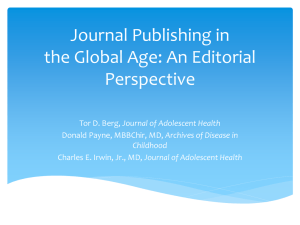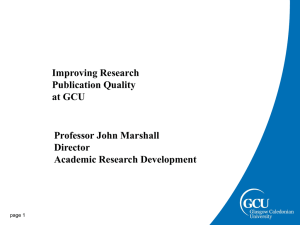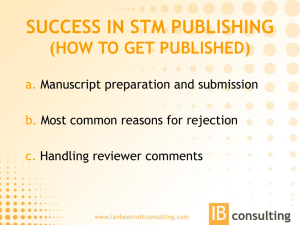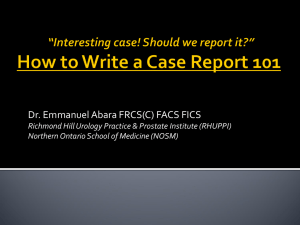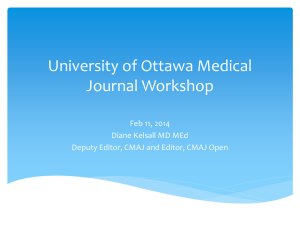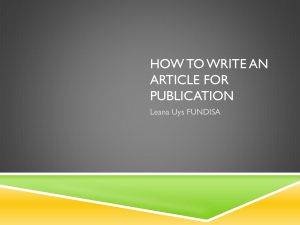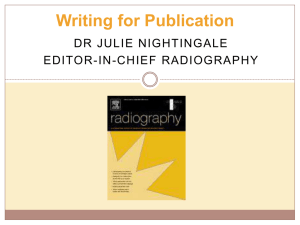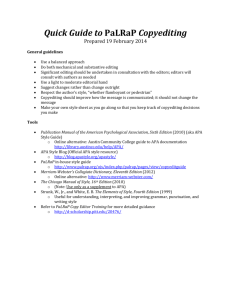Writing and Publishing for an International Journal: How – and Not
advertisement
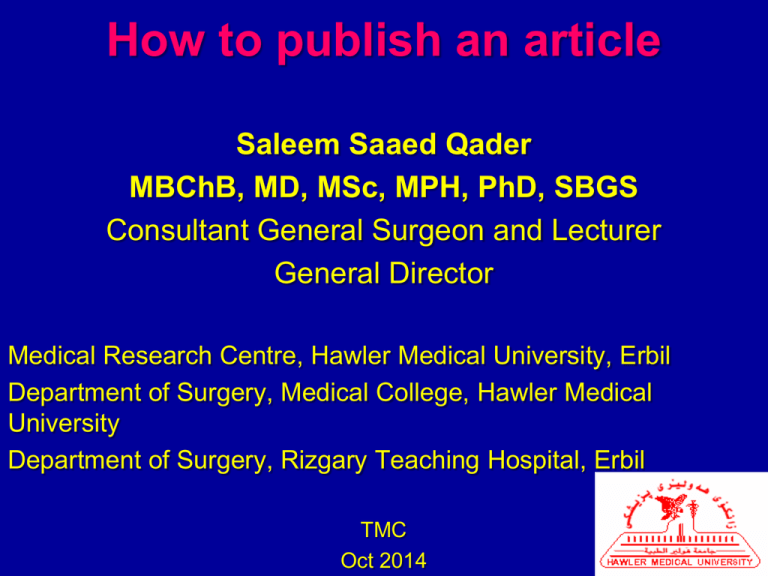
How to publish an article Saleem Saaed Qader MBChB, MD, MSc, MPH, PhD, SBGS Consultant General Surgeon and Lecturer General Director Medical Research Centre, Hawler Medical University, Erbil Department of Surgery, Medical College, Hawler Medical University Department of Surgery, Rizgary Teaching Hospital, Erbil TMC Oct 2014 Scientific paper Is a written and published document A report describing original research results 1. 2. 3. 4. 5. To assess observations To repeat experiments Must have an impact Available to scientific community without restriction Available for regular screening by one or more of the major recognized secondary services (Pub Med etc…) Brilliant writing can NOT mask a poor experiment But poor writing can mask a brilliant experiment Publish OR Perish? Publish AND Flourish! Why should scientists publish? Academic career depends on publication list Getting employ easier (to get you short listed) To share COMMUNITY with something that advances (not repeats) knowledge in a certain field To present a review/ summary of the field A scientific experiment is not complete until the results have been published & understood The knowledge should be distributed to all others Knowledge could not be circulated without publication Stages of Publication? Draft Manuscript Submitted Under revision In press Published Which journal? Where to look for the journal: Personal experience Colleagues’ experience Library Citations and published articles Online PAUSE & PONDER Questions to answer in choosing a journal 1. National or international audience? 2. Language? 3. Disciplinary? 4. The journal’s content area/culture? 5. Chances of acceptance? 6. Indexed journal (PubMed) 7. What about the impact factor? 8. Practical matters (time to publication, etc.) Know your journal targets? a) Impact factor and prestige b) Content of one of the journal issues a) Which kind of manuscripts are published ? b) What are the preferred formats ? c) Style and recent trends in the journal d) Who is the editor-in-chief ? Can you contact him ? e) Who are the members of the editorial-board? They are very aware of the journal’s publication policy f) How much it costs? g) Citation index Nature around 20 On Publications Authorship all authors must have scientific contribution How many authors? No matter how many are ... Review process getting a postive comments means that you are able to publish the paper You need to convince editors that your topic is interested and significant: Letters to editros/ cover letter Approval copy Any conflict Submission process The average reviewing time (assistant of the editors) Is there an online submission process? Can you track your manuscript status online? Citation rates The Institute of Scientific Information (ISI) records scientific citations/references Citation Index: The number of times a publication has been cited within a certain period Published annually in the Journal Citation Reports Impact factor The recorded number of citations within a certain year (eg 2003) to the items published in the journal during the preceding two years (e.g. 2001 and 2002) Citation Half Life How long articles in a journal continue to be cited after publication Calculating the BMJ’s impact factor for 2003 Impact Factor: Oncology 1998 1999 2000 2001 2002 10.730 12.945 14.159 14.240 14.500 J of Clinical Oncology 8.228 7.963 8.773 8.530 9.868 Cancer Research 8.370 8.614 8.460 8.302 8.318 Clinical Cancer Research 2.941 3.442 4.643 5.076 5.991 Oncogene 6.192 6.517 6.490 6.737 5.979 Gene Chromosome Cancer 3.804 4.902 4.534 4.416 4.199 Int Jrnl Cancer 3.283 3.545 3.918 4.233 4.056 Cancer 3.660 3.362 3.611 3.909 3.941 Annals of Oncology 2.867 3.195 3.249 3.153 3.114 J Natl Cancer Institute Getting your paper accepted Keep it simple (focus on one specific theme) Announce that idea in abstract, intro & conclusion Follow style and structure the journal you have in mind If more ideas or themes come to mind: split it off for future publications Help Editors/ Referees (and yourself); Number all pages Re-writing Be prepared to re-write and revise and revise Go through revisions and feedback: colleagues, supervisors, native speakers, editors. Follow suggestions from editors Welcome useful suggestions but make sure you remain coherent & consistent If you disagree with reviewer’s suggestions: make a case to the editor Be self-critical, but not to the point of paralysis What to do with rejected papers? Read rejection letter, don’t send angry impulsive emails Return to it after a couple of days? Take criticism into account, may be change angle of the paper, focus on strongest points, if necessary rework design & analysis Submit to another journal See it as new project Aim for a slightly less prestigious journal Who is going to deal with your paper? Editors and reviewers: 1.The most precious resource of a journal! 2. Practicing scientists, even leaders in their fields 3. Busy people doing their own research, writing and teaching, and working for journals in their spare time, to contribute to science Editors may receive a small payment, but reviewers are UNPAID QUALITY The heart of scientific communication Do not publish: 1. Reports of no scientific interest 2. Duplication of previously published work 3. Incorrect/unacceptable conclusions 4.“ salami-sliced” papers: datasets too small to be meaningful Deadly sinsUnethical behavior “ can earn rejection and even a ban from publishing in the journal” — Terry M Phillips, Editor, Journal of Chromatography B Multiple submissions Redundant publications Plagiarism Data fabrication and falsification Improper use of human subjects and animals in research Improper author contribution Why is revision important and necessary? Which procedure do you prefer? Send out a sloppily prepared manuscript get rejected after 4-6 months send out again only a few days later get rejected again…. Take 3-4 months to prepare the manuscript get the first decision after 4 months revise carefully within time limitation….accepted Please protect your own achievements! Before submitting your article 1. Check the originality of your idea Have you done something new and interesting? Is there anything challenging in your work? Have you provided solutions to any problems? 2. Decide the type of your manuscript Full articles/Original articles; Letters/Rapid Communications/Short communications; Review papers Ask your colleagues for advice: Sometimes outsiders see things more clearly than you 3. Who is your audience? Do you want to reach specialists, multidisciplinary researchers, a general audience? Journals reach readers with different background Is readership worldwide or local? 4. Choose the right journal Investigate all candidate journals to find out: Aims and scope and types of articles You can get help from your colleagues Articles in your references will lead you to the right journal DO NOT scatter your manuscript to many journals Only submit once! The Process of publishing an article Writing the manuscript: Moral and ethical standards Obtaining data, analyzing results and writing IMRAD Revision and revision and revision Getting feedback (supervisor and coauthors) Finding journals (instruction to the author) Submitting (confirmation letter) Revisions (changes and comments) or rejection 2. Revision after submittion: Carefully read the comments and prepare a detailed letter of response Reasons for rejection Did not address important scientific issue Not original Did not test authors hypothesis Different study should have been performed Sample size too small Uncontrolled or inadequately controlled Analyze incorrect or inappropriate Unjustified conlcusion reched from data Significant conflict of interest Badly prepared regarding submittion requirements or poor English Rejection: not the end of the world Everyone has papers rejected-do not take it personally. Try to understand why the paper was rejected. Note that you have received the benefit of the editors and reviewers’ time; take their advice seriously! Re-evaluate your work and decide whether it is appropriate to submit the paper elsewhere If so, begin as if you are going to write a new article Read the guide for authors of the new journal again & again Don’t resubmit a rejected manuscript to another journal without significant revision! It won’t work What to avoid in the paper Superficial literature search, Wikipedia-based Don’t claim that “very little” research has been done in an area if you’re not 100% sure! => reviewers may react negatively Sloppiness in presentation of text: respect style sheet, make sure references are in right format, double-check list of references, make sure spelling of surnames is correct Style that does not match that of journal Taking a side in a debate & ignoring the counter-arguments Moral standards Establish a reputation of a reliable & honest researcher (always acknowledge your sources) Be prepared to give advice to those who seek your advice Accept to review papers (journals)/ chapters Stick to deadlines Don’t be pretentious, don’t take your work too seriously Be optimistic and friendly with colleagues If you guessed who reviewed your paper and you meet that person: don’t start talking about the paper unless the reviewer starts about it Ethical standards As a reviewer in an international journal Make sure you give constructive criticism together with your honest opinion Never be nasty or dogmatic Don’t cite/use data of a paper you revised If you wish to contact the author/s, ask the editor to pass on the message Final recommendations Research is fun! Publish and flourish! (it’s a game really) Writing up requires patience & perseverance: it is worth the effort! Nobody is perfect: everybody sweats! Be thankful of the reviewer who sends you a 10 page report with criticism & comments: that person has spent a lot of time and effort on your work (and it may be a major name, who might start referring to your work) What mark have you thought to leave after?

